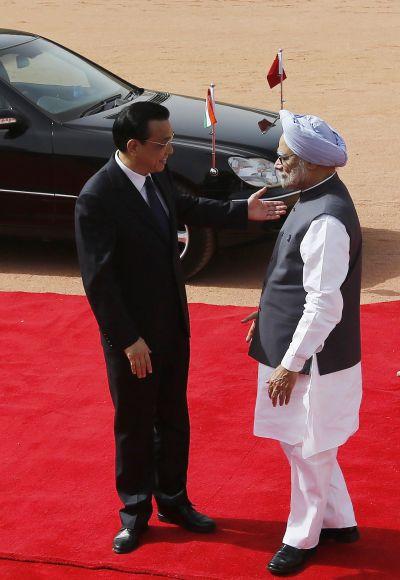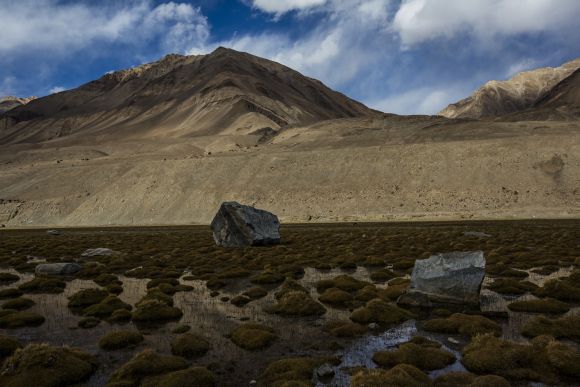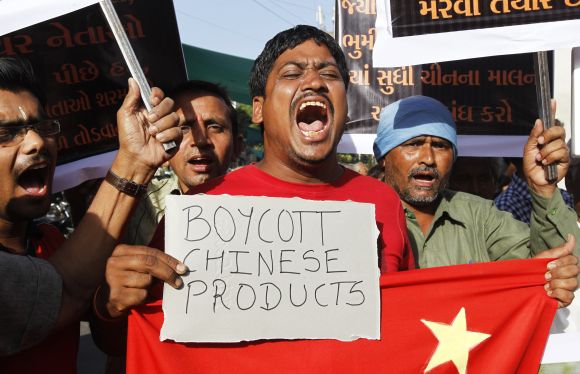 | « Back to article | Print this article |
How the Indian media helped defuse crisis with China
By sensitising the entire nation of this unprovoked incursion and the resultant mood of anger among Indians, the media had set into motion rapid official and diplomatic developments not only in New Delhi but also in Beijing, writes Air Marshal (retd) Bhushan Gokhale.
Having assumed the second position in leadership hierarchy only a couple of months ago or in March this year, it is very significant that the Chinese Premier Li Keqiang had chosen to visit India as his first official destination. Going by the joint statements and renewed commitment for ensuring peace and tranquillity along the unresolved boundary issue, there is an optimistic feeling of a new beginning in the relations between the two neighbouring Asian giants.
The visit was even more significant coming in the wake of a three-week standoff at Daulat Beg Oldi sector, which started on April 15 and ended on May 5, after the withdrawal of almost 50 Chinese troops who had set up a temporary camp 19 km inside the Line of Actual Control.
While the Indian establishment is still grappling with the rationale of such incursion just prior to the high-level visit, I wish to compliment the Indian media for its significant and positive role in defusing the stand-off. By sensitising the entire nation of this unprovoked incursion and the resultant mood of angry Indians, it had set into motion rapid official and diplomatic developments not only in New Delhi but also in Beijing in what was initially termed as an incident at the 'local level'.
Air Marshal (retd) Bhushan Gokhale is a former vice chief of air staff
Please click NEXT to read further...
Did government tip off the media about the standoff?
But how did media come to know of this incursion in the first place? This is intriguing, since no news reporters are allowed in these forward positions, which are manned by either the Indo Tibetan Border Police or the Indian Army.
Adding to this intrigue was the access to the media of the actual photographs of the Chinese camp of five tents and some vehicles used for logistical supplies. These were also flashed repeatedly on the electronic media in the preceding tense days till the Chinese withdrawal.
Was the news of the incursion deliberately leaked to the media by the government, the ITBP, the Army or any other agency in the establishment? If so, I must then compliment both the establishment and the media.
While efforts were on to downplay the hype even after three unresolved flag meetings, the hostile reaction of the Indian population was significant and evident. Surprisingly, the Chinese media was somewhat indifferent to this growing tension with India. There were some reports of Chinese displeasure at Indian attempts to build infrastructure in areas near the Line of Actual Control, which the Chinese consider as yet to be resolved.
Coming in the wake of the Chinese premier's visit to India, downplaying of the incident from their side was evident from a comment made by Dr Liu Youfa, consul general of the Peoples' Republic of China in Mumbai, who said, "When I come to your house as a guest, would you expect me to throw a stone at your window before coming in?"
In the days to come, the reasons as well as the timing for this incursion will be debated and analysed. In my opinion, the Chinese did this out to serve two purposes. First, coming almost immediately after the changeover of the PRC leadership for the 'next decade', it was signalling a message that the Chinese are ready to flex their muscle, regardless of India or any other neighbouring countries trying to join hands with outside powers like the United States of America.
Second, it helped in displaying her 'big brother' image of granting a concession by withdrawing the troops just prior to Premier Li Keqiang's visit to India. The Indian Army also has had to withdraw from what can be termed as India's own territory.
Please click NEXT to read further...
Border standoffs no more 'hush hush' affairs
In this second rationale the Indian media made a significant contribution, as there were protests on the streets to ban Chinese goods and reports of some stray incidents of burning of Chinese merchandise, also shown repeatedly by the electronic media.
With bilateral trade increasing significantly in recent years on one hand and sizeable reduction in Chinese exports to the US and European Union in the last few years on the other, at least for the present moment the Chinese would not want to lose their Indian market share.
It seems that at least for the present the Chinese are ready to vacate a few square kilometres of land in the DBO sector. However, in doing so they have extracted an Indian troop withdrawal from our own territory, strategically important to both the countries, being close to the Karakoram highway.
Throughout my career I have heard phrases suggesting 'managing or influencing or calibrating the media'. But currently we are not living in the days when the media was considered to be a mouthpiece of the government. Large numbers of dailies and periodicals as well as an equally large number of television media channels rightly reflect the India of today, which is a pluralistic and vibrant democracy, with the media free to express various views.
With the maturing of our democracy, the Fourth Estate is also staking a claim to not only influence the readers and viewers but is also becoming an opinion-maker, especially when incidents like the Chinese standoff take place.
Years ago, while analysing the criticism against BBC's reporting during the Falkland War, I remember asking a senior Indian journalist what in his opinion was the dividing line between national interest and freedom of expression.
The American media had also come under criticism during the Vietnam War. Most of us also had similar questions in our mind when Indian TV channels were reporting live about commandos rappelling down from a helicopter on to the roof of Nariman House during the 26/11 terrorist attack in Mumbai.
However, since 26/11, the media, also slammed by the Supreme Court for inappropriate reporting, has agreed to self-restraint. In spite of the inevitable race for circulation and viewership, one can expect matured reporting by the media, enough to keep the public informed, and in turn serving as a watchdog to ensure checks and balances.
On the other hand, it is equally noteworthy that the 'CNN effect' of extent and speed of new media does help in influencing policy decisions.
In my opinion a collaborative approach between the establishment and media is important to avoid reporting of half-baked news, if one is to take advantage of what the French emperor Napoleon Bonaparte had observed as, 'Four hostile newspapers are more feared than a thousand bayonets'.
TOP photo features of the week
Click on MORE to see another set of PHOTO features...



